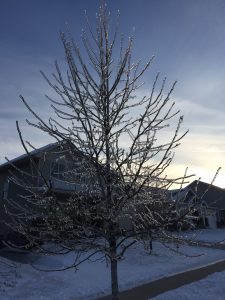
Ice coating an urban tree from a late February 2017 storm in south central Wisconsin.
Several ice storms have impacted yard and forest trees in southern Wisconsin in 2016/2017. The combination of trees coated in heavy ice and strong winds caused broken branches and bent or broken main stems. Working with storm damaged trees can be very dangerous, so landowners should carefully consider safety concerns and get help from professional arborists or foresters when appropriate.
Ice storms can have severe consequences for urban and rural forest trees. The amount of damage will depend on how much ice accumulates, how long the ice lasts and wind speed. Typical damage from ice storms includes broken branches, bent main stems, broken main stems, splitting of trees with multiple stems and up-rooting. This damage can be worsened by attempting to remove ice from affected trees so it’s best to let the ice melt naturally.
Safety of people and property is the first concern after an ice storm. Damage to trees may result in numerous hazards, so consider contacting a professional arborist or forester to assess the situation and provide advice. The Wisconsin Arborist Association provides certified arborist information for urban trees. The Wisconsin Department of Natural Resources has foresters and forest health staff who can advise on damage to forests.
After safety concerns are eliminated, develop a plan to deal with damaged trees. This may involve pruning broken branches, tree removal or a variety of other actions. Being proactive in maintaining tree health will help your trees avoid ice damage. Maintain yard tree health by: 1) properly planting new trees in areas with plenty of space for roots to grow, 2) correctly pruning and mulching, 3) watering during dry periods and 4) keeping trees free of insects and diseases. In forests, proper forest management activities like thinning overcrowded stands and removing poor quality trees will help prevent damage. Landowners should consider working with a forester to develop a forest management plan that includes their objectives for the property so when ice or other damage occurs they will have a strategy for getting the forest healthy again.
Susceptibility to ice damage is one factor to consider when choosing a tree. For additional information about tree susceptibility to ice damage and other considerations see Trees and Ice Storms by Richard Hauer (longer version with more information).
Written by: Mike Hillstrom, forest health specialist, Wisconsin Dells (Michael.Hillstrom@wisconsin.gov), 715-459-1371.
